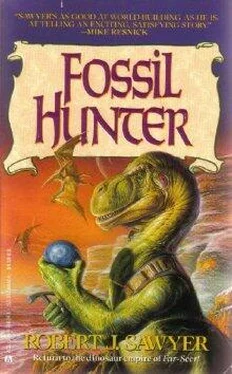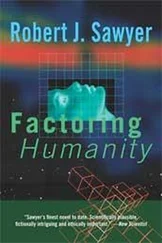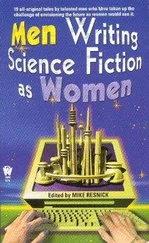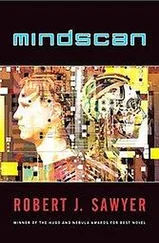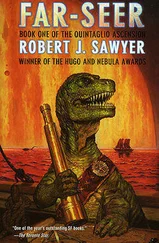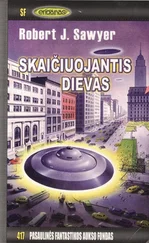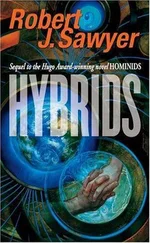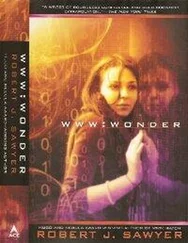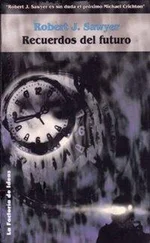Robert Sawyer - Fossil Hunter
Здесь есть возможность читать онлайн «Robert Sawyer - Fossil Hunter» весь текст электронной книги совершенно бесплатно (целиком полную версию без сокращений). В некоторых случаях можно слушать аудио, скачать через торрент в формате fb2 и присутствует краткое содержание. Год выпуска: 1993, ISBN: 1993, Издательство: Ace Science Fiction, Жанр: Фантастика и фэнтези, на английском языке. Описание произведения, (предисловие) а так же отзывы посетителей доступны на портале библиотеки ЛибКат.
- Название:Fossil Hunter
- Автор:
- Издательство:Ace Science Fiction
- Жанр:
- Год:1993
- ISBN:0-765-30793-4
- Рейтинг книги:5 / 5. Голосов: 1
-
Избранное:Добавить в избранное
- Отзывы:
-
Ваша оценка:
- 100
- 1
- 2
- 3
- 4
- 5
Fossil Hunter: краткое содержание, описание и аннотация
Предлагаем к чтению аннотацию, описание, краткое содержание или предисловие (зависит от того, что написал сам автор книги «Fossil Hunter»). Если вы не нашли необходимую информацию о книге — напишите в комментариях, мы постараемся отыскать её.
trilogy depicts an Earth-like world on a moon which orbits a gas giant, inhabited by a species of highly evolved, sentient Tyrannosaurs called Quintaglios, among various other creatures from the late cretaceous period, imported to this moon by aliens 65 million years prior to the story.
Fossil Hunter — читать онлайн бесплатно полную книгу (весь текст) целиком
Ниже представлен текст книги, разбитый по страницам. Система сохранения места последней прочитанной страницы, позволяет с удобством читать онлайн бесплатно книгу «Fossil Hunter», без необходимости каждый раз заново искать на чём Вы остановились. Поставьте закладку, и сможете в любой момент перейти на страницу, на которой закончили чтение.
Интервал:
Закладка:
It was wonderfully, terribly clear what was happening. Both the reptiles and the mammals were on their way to intelligence, and at about the same rate, too—the ratio of brain size to body size was increasing on a simple curve through time, and the scale-clad and fur-bearing creatures were both at the same point on that curve. The brightest of the reptiles and the brightest of the mammals soon had brains of equal, if as yet insignificant, power.
It would still take a long time for real intelligence to develop on this world—some 60 or 70 million Crucible years, I judged. But the mammals had already come up against a dead end. Intelligence, at least in the way these beings were trying to express it, required physical bulk—large, centralized, convoluted brains. The reptiles had long dominated every ecological niche for big animals; the rise of mammalian intelligence had ground to a halt.
Not one, but two potential paths to sentience. Yet only one of them, it seemed, could make it on this world.
I summoned the Jijaki.
Toroca, Babnol, and Keenir headed toward the ice in a shore boat. It took Keenir a while to find a suitable place to land. Even so, he wasn’t able to anchor the boat properly, so he had to stay with it to keep it from drifting away and stranding them. Toroca and Babnol, clad from muzzle to tail in their strange, bulky garments, headed out onto the ice pack. The surface was covered with hard snow that cracked or squeaked when they stepped on it. Toroca was amazed at its texture, like frozen waves.
And the brightness! Glaring white, everywhere he looked. He found himself shielding his face with his arm. Even with his eyes narrowed to slits, it was still difficult to see.
As his eyes adjusted to the glare, Toroca was surprised to see that there were insects here: little black things that hopped across the snow. But it wasn’t those that had caught his attention from the deck of the Dasheter , but, rather, the strange creatures visible just ahead.
“Why don’t they run?” Babnol’s words were all but stolen away on the shrieking wind.
“What?” called Toroca.
“Why don’t they run from us?” she said again. “Aren’t they afraid?”
There were thousands, perhaps tens of thousands, of the creatures covering the ice, each one like a drop of quicksilver in the low Antarctic sun.
“They don’t seem to be.”
“How can they not be afraid of animals bigger than they are? Certainly, they have no way to defend themselves.”
Toroca and Babnol stepped closer, the snow so hard that they left no footprints in it. “And look at the way they crowd together!” said Babnol. “They could touch each other without moving, if they wanted to. Have they no notion of territoriality?”
“Lots of herbivores herd.”
“Excuse me, Toroca, you are the scholar, but, umm, there are no plants around, in case you hadn’t noticed. These creatures must be fish-eaters.”
The creatures had little round bodies and strange heads that were drawn out into long points both off the front of the face and at the back of the head. There was no doubt that they had seen the approaching Quintaglios. Many had swiveled these heads toward Toroca and Babnol. But they seemed not in the least alarmed by the intruders. Toroca saw one slide lazily off the ice into the water. Others were preening themselves with their long prows.
For want of a better name, Toroca thought of these creatures as divers . They seemed to have no qualms about slipping into the freezing water, and when they went beneath the surface, Toroca lost all track of them. They were presumably diving deep.
There were only about twenty paces between Toroca and the closest of the divers now. Most of the divers were flopped on their bellies, but some stood fully erect, with thick flippers hanging at their sides. There was something red about halfway down the leading edge of each flipper, but Toroca couldn’t yet make out what it was.
As if the complacency of the divers wasn’t baffling enough, one of the larger divers began waddling toward Toroca and Babnol. The thing’s gait was awkward, its short legs not allowing very fast movement. As it approached, Toroca saw that its prow—more of a beak, really—had interlocking pointed sides, but whether these were protruding teeth or simply a saw-toothed edge to the horny sheath, he couldn’t say. Still, although the sharp edges were doubtless effective against fish, they didn’t look like they could do much to a Quintaglio. Pointing in exactly the opposite direction of the beak was a similarly tapered crest off the back of the head.
Low on the far horizon, almost lost in the glare from the ice, Toroca could see two crescent moons. Given the position of the sun, Toroca and Babnol should have been casting long shadows in front of themselves, but the ice and snow were so reflective that ambient light bounced in to banish them.
The big diver continued to come closer, it seeming to take five or six left-right waddles to cover the distance Toroca traveled in a single step. Toroca could see the animal’s flippers better now. The red growths in the middle of the flippers’ front edges were claws—three small, curved claws. Toroca couldn’t imagine what use they were to the animal there, although perhaps they could act as brakes should the diver’s waddling gait fail and it found itself facedown sliding across the ice.
There was now just a semi-ten of paces between him and the vanguard diver. Other divers were watching with perhaps growing interest, but no real sign of concern. Suddenly Toroca got the feeling that perhaps he was being set up. The long forward-facing tunnel of his snow jacket kept his muzzle warm at the expense of eliminating peripheral vision. Toroca swung his head in a wide arc and then turned around, almost slipping on the ice as he did so, to check behind him. Nothing, except Babnol, looking as surprised as Toroca felt.
In some ways, it didn’t seem sporting. Toroca was no fan of the hunt, but he understood that part of the excitement was the pursuit. He’d never had an animal walk up to him before. For one brief moment he thought that perhaps this meant the diver wasn’t an animal. But that was silly. Besides, the diver had a tiny head, and the pointed projection off the top, apparently counterbalancing the beak, seemed to be a rudder-like crest, not an enlarged braincase.
That the animal was completely without fear was puzzling. And yet, it had never seen a Quintaglio before (and really wasn’t seeing one now, Toroca thought, since the thick winter vestments hid all of Toroca’s body except for the tip of his face). Perhaps the beasts had no predators here. Certainly that would explain their vast numbers.
Toroca took another step forward and was now close enough to the diver to touch it. Its little streamlined body was covered with short silver fur that seemed to glisten, as though slicked down with oil. He could see it breathing in and out, its rounded torso expanding and contracting. Although walking seemed to be something of an effort for it, the diver had by no means been really exerting itself. The fast pace of its breathing therefore must mean that it was indeed warm-blooded, something the insulating fur had suggested anyway.
Toroca simply wanted a specimen for study, of course. He reached down with both arms and, using a scalpel, its metal bitterly cold, its surface frosted, he slit the diver’s throat.
As soon as the knife touched its skin, the diver let out a call like wooden boards clacking together. That evidently meant something to the other divers, because they started making the same call.
The tableau held for several beats, the only sound the washboard calls of the divers, the only movement their pointed beaks and the flow of blood onto the ice from the dead diver, the red liquid already thick and sluggish in the cold.
Читать дальшеИнтервал:
Закладка:
Похожие книги на «Fossil Hunter»
Представляем Вашему вниманию похожие книги на «Fossil Hunter» списком для выбора. Мы отобрали схожую по названию и смыслу литературу в надежде предоставить читателям больше вариантов отыскать новые, интересные, ещё непрочитанные произведения.
Обсуждение, отзывы о книге «Fossil Hunter» и просто собственные мнения читателей. Оставьте ваши комментарии, напишите, что Вы думаете о произведении, его смысле или главных героях. Укажите что конкретно понравилось, а что нет, и почему Вы так считаете.
